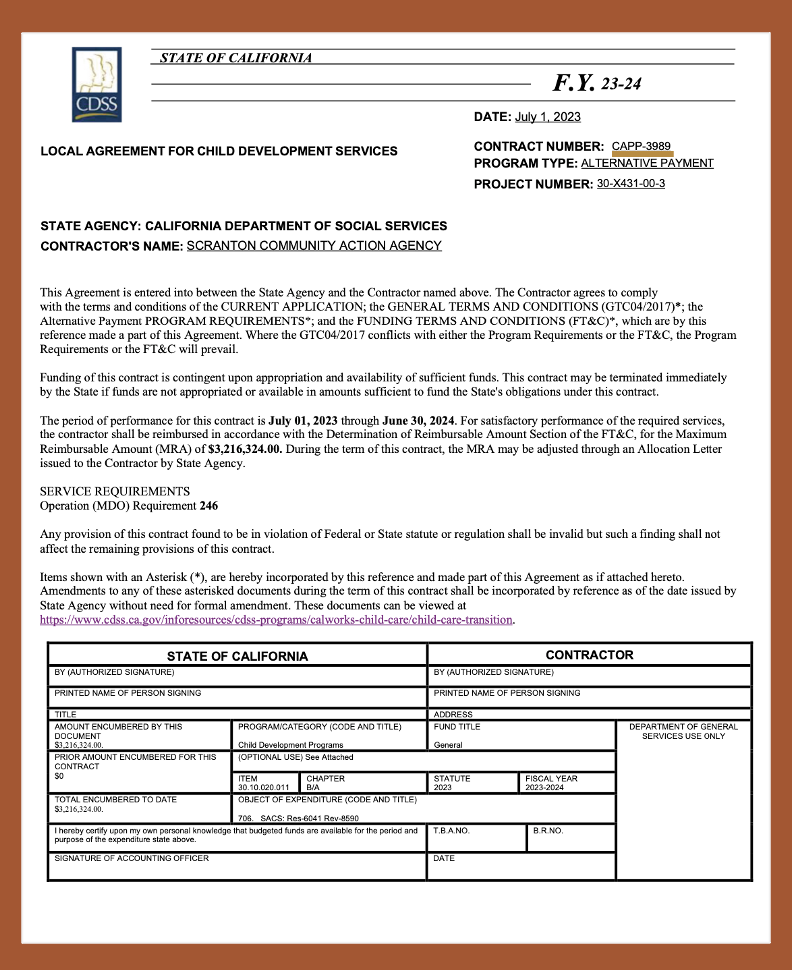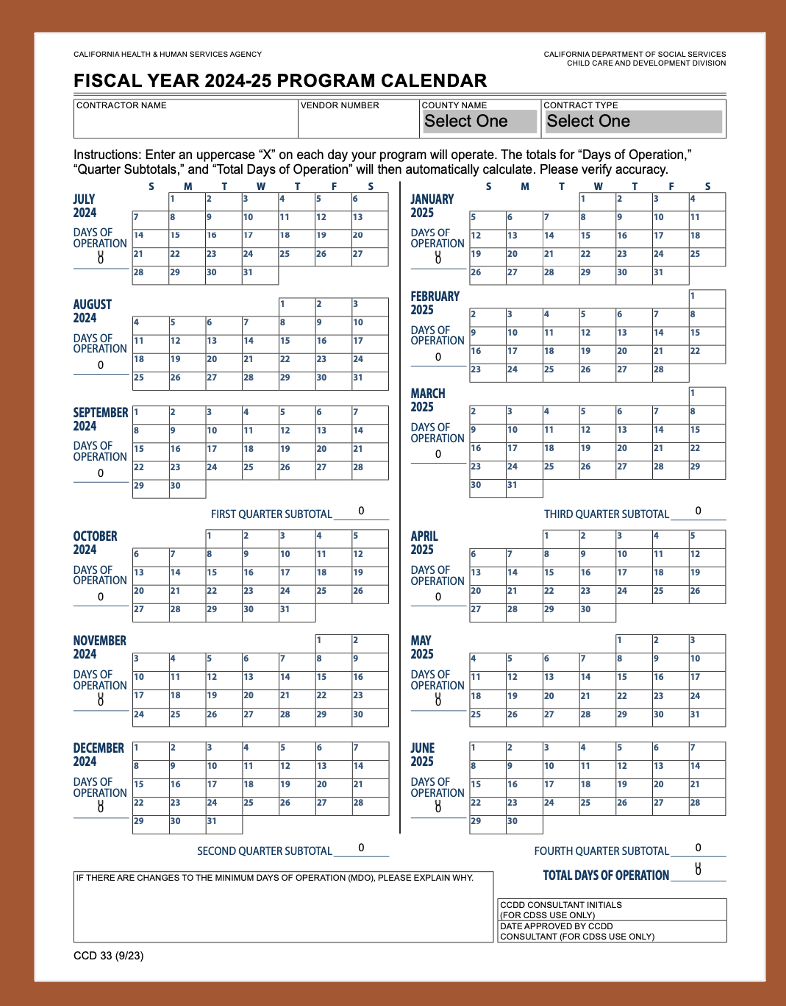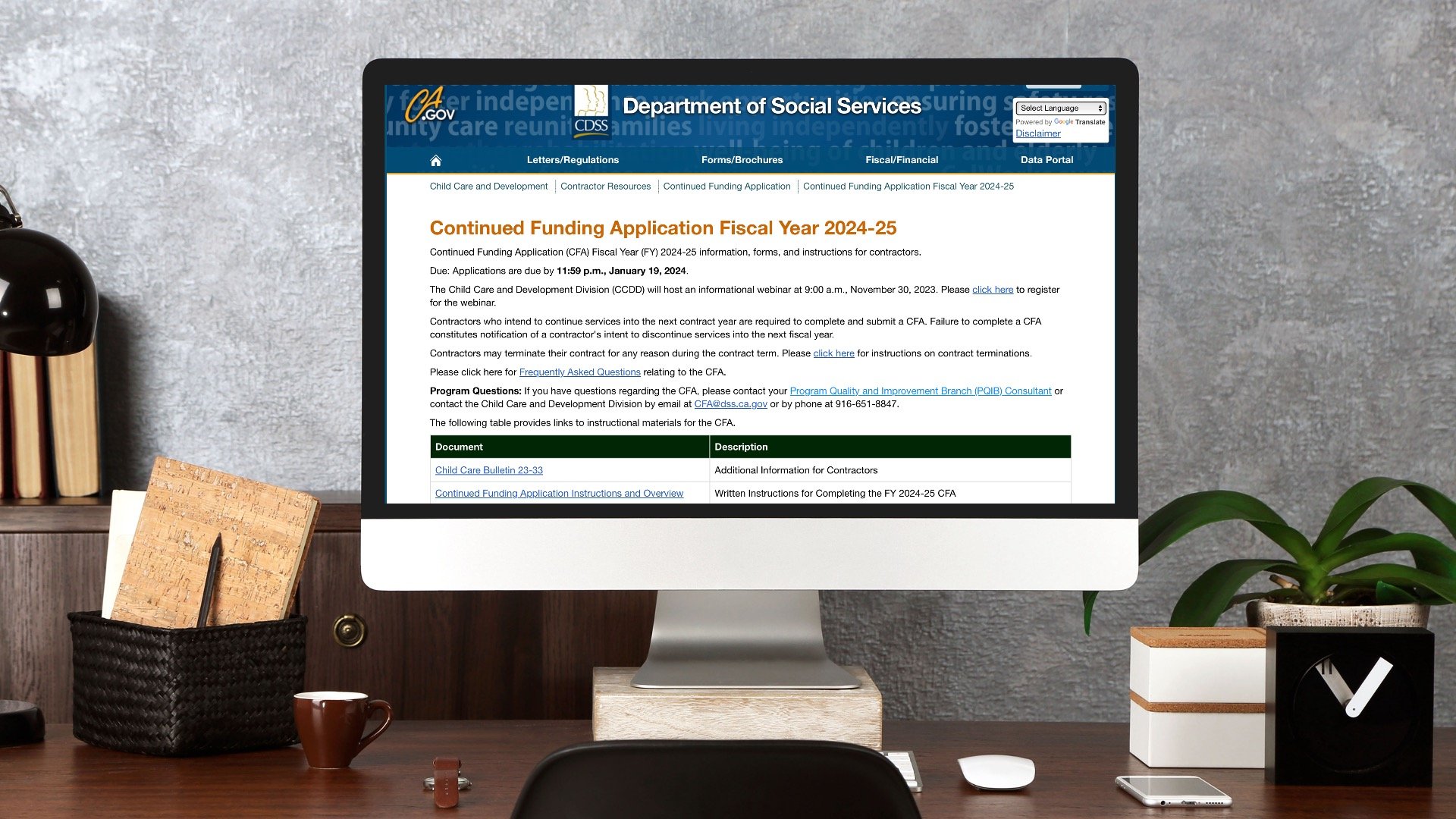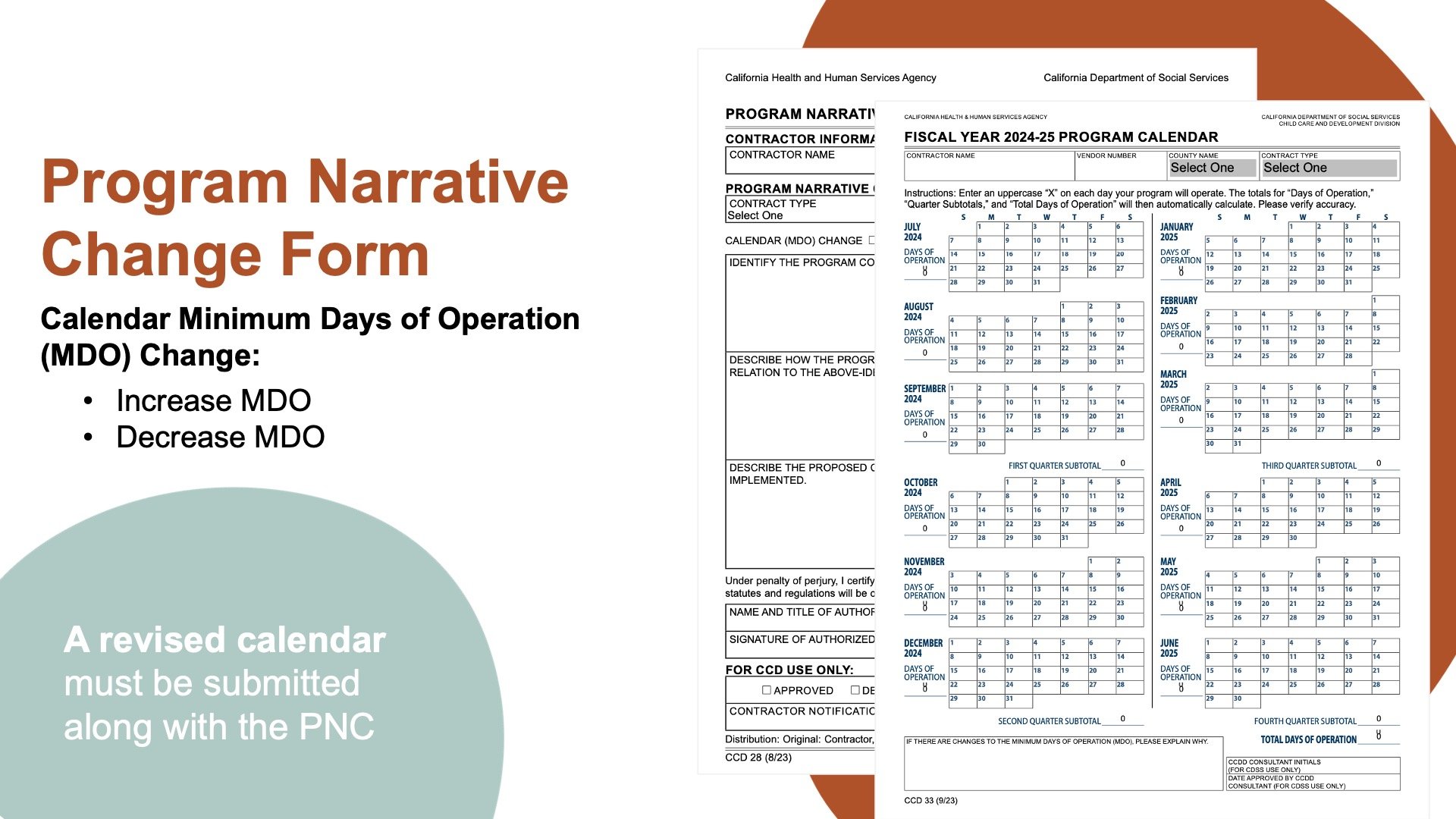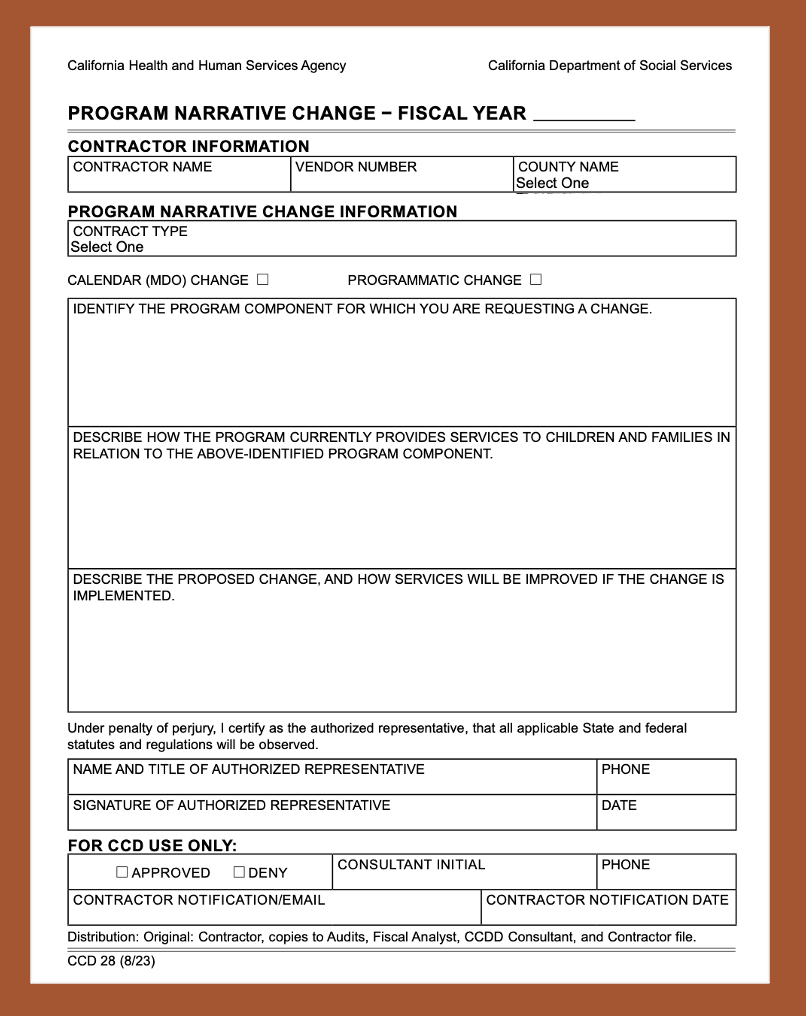Lesson
Dashboard
Lesson 1
Family Selection
Lesson 2
Family Data File
Lesson 3
Attendance
Lesson 4
Provider Participation
Lesson 5
Provider Reimbursement
Lesson 6
Parent Involvement & Education
Lesson 7
Health & Social Services
Lesson 8
Site Licensure
Lesson 9
Adult-Child Ratios
Lesson 10
Environment Rating Scale
Lesson 11
Nutritional Needs
Lesson 12
Desired Results Profile & Data
Lesson 13
Qualified Director
Lesson 14
Staff Development/Provider Support
Lesson 15
Refrain from Religious Instruction
Lesson 16
Inventory Records
Lesson 17
Annual Evaluation Plan
Lesson 18
Fiscal Essentials: CFCC Contract Type
Introduction
Before building an enrollment & projection plan, it’s important to know & understand what is on your program contract.
Reference
Watch Video Lesson ❯
Sample Forms/Tools ❯
Review Sketch Pad Notes ❯
Request for Applications
Request for Applications also referred to as RFA is released as funds become available.
Department issues notification to contractors via a Child Care Bulletin. Interested applicants can apply electronically using the online portal that will be made accessible through a link on the Child Care Bulletin.
NOTE: Being awarded does not immediately mean that a contractor is given a contract. There is communication that happens between the fiscal analyst and the new contractor before the contract is created. Potentially the award amount is prorated for the first year of operation.
Contracts/Amendments
Once awarded, a contract for new applicants or a contract amendment for existing applicants is issued.
Contract Information
The contract is a legally binding agreement between a child care contractor & the Department in which the contractor agrees to provide child development services according to defined programmatic & fiscal requirements.
Contracts are sent to the e-mail addresses for both the Executive Director & Program Director on file.
Contractors who apply for & are approved for continued funding through the CFA process will be automatically renewed in accordance with all applicable federal & state laws, as well as all Funding Terms & Conditions & Program Requirements that will be incorporated into the program contract.
NOTE: Failure to respond within the CFA timelines shall constitute as notification of the contractor’s intent to discontinue services at the end of the current contract period.
Once the contract is executed by the Contracts Office, it becomes eligible for payment. No apportionments can be made until a contract is deemed executed by the Contracts Office.
Not all amendments will require a signature. Contract amendments that do not require a signature will be processed as an Allocation Letter which will look similar to a contract amendment, & will include the contract face sheet & any changes in funding, where applicable.
Contract amendments that require a signature will be issued via a Contract Amendment. These may include:
Legal Address or Name Change
Vendor Number Change
Program Narrative Change
Expansion Funds/Start-up
Contract Relinquishment
Program Type
Some agencies operate one program type, while others operate many. A separate contract is issued for each program type.
The first four characters designate the program type. The first number designates the fiscal year, which is the last digit of the first half of the fiscal year. The last three numbers are the contract sequence number within that program type.
Maximum Reimbursable Amount
The Maximum Reimbursable Amount, also known as MRA, means the total dollar amount of a contract. This is the most that an agency will be paid for their child services or reimbursable expenses in a given fiscal year.
NOTE: Changes to the MRA during the fiscal year will require an amendment to the contract.
The MRA is located within the narrative & within the table. In the event the the contract is amended, it will show both the prior encumbrance, amended encumbrance & new maximum reimbursable amount.
Budgeting Costs
Contractors can budget to spend up to the maximum limits of reimbursement for administrative & support costs with the remainder of their Maximum Reimbursable Amount (MRA) budgeted for provider payments.
The amount earned consists of reimbursable expenditures of direct provider payments, which is 70% of your program revenue & actual administrative & support costs related to services provided, which combined cannot exceed 30% of the total contract amount.
NOTE: Contractors will never receive more than 30% for admin & support. If a contractors admin & support costs exceeds 30%, they CAN NOT take from the amount set aside for provider payments.
Minimum Days of Operation
A “Day of Operation” is a day in which the contractor’s administrative office is open for business.
The Minimum Days of Operation (MDO) is determined by the service calendar submitted annually for each program.
NOTE: If the Minimum Days of Operation need changed, submit a revised Program Calendar, along with a Program Narrative Change form.
Continued Funding Application
After the initial contract period, the contractor’s eligibility for continued funding each subsequent year is contingent upon compliance with all department & statutory requirements along with the completion & submission of a Continued Funding Application (CFA).
Each year around November, the Department issues a Child Care Bulletin notifying contractors of the release of the Continued Funding Application for contractors who intend to continue services into the next contract year.
Contractors who apply for & are approved for continued funding through the CFA process will be automatically renewed.
NOTE: Failure to respond within the timelines specified in the CFA request shall constitute notification to the Department of the contractor’s intent to discontinue services at the end of the current contract period.
Program Narrative Change(s)
As part of the Continued Funding Application & as contract changes arise, contractors must submit a Program Narrative Change (PNC) form along with support documentation to the Department for approval.
Calendar (MDO) Change
Calendar Minimum Days of Operation (MDO) changes include an increase or decrease to the MDO.
A revised calendar along with supporting documentation to substantiate the requested change must be submitted along with the Program Narrative Change form (PNC) & must be completed within the fiscal year preferably by May 1st.
Be cautious with calendar changes as this may impact your monthly funds.
On year-end calculations, if the actual days of operation are greater than or equal to 98% of the Minimum Days of Operation, the Maximum Reimbursable Amount will not be affected.
If actual days of operation are less than 98% of the Minimum Days of Operation, the Maximum Reimbursable Amount will be reduced in proportion to the percentage of contract minimum days of operation that the contractor was not in operation. This could result in a billing if the contractor has been paid more than the reduced Maximum Reimbursable Amount.
If there are date changes to your program calendar but the MDO will remain the same, contractors are not required to submit a PNC however, contractors must email their assigned PQI consultant & include a copy of the revised calendar.
Programmatic Change
Programmatic changes include but are not limited to changes to the service area.
The contractor must submit the PNC form along with any support documentation to support the request such as a parent survey or needs assessment.
PNCs submitted at the time of the Continued Funding Application for the upcoming fiscal year will receive an email notification of the approval or denial of their CFA & requested change.
Complete Knowledge Check ❯
After reviewing the video lesson & sketch pad notes, it’s time to check for understanding by completing a Knowledge Check. Note that Individual Knowledge Checks will conclude with a Certificate.





